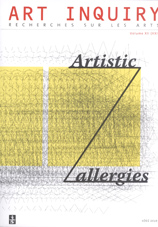The hidden other. Clothing as an art object
The hidden other. Clothing as an art object
Author(s): Magdalena SamborskaSubject(s): Fine Arts / Performing Arts
Published by: Łódzkie Towarzystwo Naukowe
Keywords: Contemporary sculpture; gender; postmodernism
Summary/Abstract: The theme of this article is contemporary sculpture which refers to clothing. This includes objects shown in galleries, performers’ costumes, as well as film or photographic documentation of ephemeral “packaging” of the human body. The artists discussed here, whose art fits this description were once marginalized because of their gender, skin color or sexual identity. In the postmodern age, they occupy the position in the mainstream of art, determined by the status of the Other. However, I am looking for a different type of otherness. Interpreting the selected works, I refer to the familiar discourses (of power, body, etc.) as well as search for other hidden meanings. The hidden other may be only suggested. His/her ethereal nature can manifest itself in allusions, distortion, or an order based on oppositions. Balaclavas decorated with symbols of power made by Rosemarie Trockel provide a curtain for a sensed different order. Costumes from the action by Rebecca Horn question the habits of the subject-object relationship. Like the miniature installations by Charles LeDray, they reverse the vectors of power. Confrontation with something infinite, beyond rational comprehension, also creates an opportunity to sense the hidden Other. Helen Chadwick’s action In The Kitchen can be interpreted as a confrontation with the infinity of space. Vanitas: Flesh Dress for Albino Anorectic by Jana Sterbak is an encounter with the mystery of death. Sometimes it is questions and concerns which arise upon viewing the work that are helpful in finding the hidden Other. The excessive details in Shonibare’s installations do not reveal the identity of the headless hero presented by the artist. Many associations and interpretative paths are hidden behind the simple description of the works of Dorothy Cross. The hidden Other avoids being captured once and for all in a definition. To describe him, to define him would destroy his essence.
Journal: Art Inquiry
- Issue Year: 2010
- Issue No: 12
- Page Range: 187-199
- Page Count: 13
- Language: English

